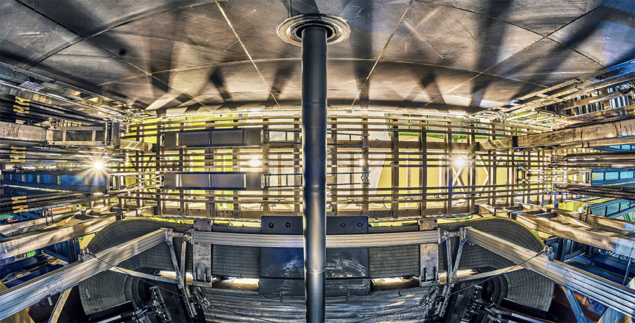
On the morning of 21 March, at the 2019 Rencontres de Moriond in La Thuile, Italy, the LHCb collaboration announced the discovery of charge-parity (CP) violation in the charm system. Met with an impromptu champagne celebration, the result represents a milestone in particle physics and opens a new area of investigation in the charm sector.
CP violation, which results in differences in the properties of matter and antimatter, was first observed in the decays of K mesons (which contain strange quarks) in 1964 by James Cronin and Val Fitch. Even though parity (P) violation had been seen eight years earlier, the discovery that the combined C and P symmetries are not conserved was unexpected. The story deepened in the early 1970s, when, building on the foundations laid by Nicola Cabibbo and others, Makoto Kobayashi and Toshihide Maskawa showed that CP violation could be included naturally in the Standard Model (SM) if at least six different quarks existed in nature. Their fundamental idea – whereby direct CP violation arises if a complex phase appears in the CKM matrix describing quark mixing – was confirmed 30 years later by the discovery of CP violation in B-meson decays by the BaBar and Belle collaborations. Despite decades of searches, CP violation in the decays of charmed particles escaped detection.

LHCb physicists used the unprecedented dataset accumulated in 2011–2018 to study the difference in decay rates between D0 and D̅0 (which contain a c quark or antiquark) decaying into K+K– or π+π– pairs. To differentiate between the identical D0 and D̅0 decays, the collaboration exploited two different classes of decays: those of D*+/- mesons decaying into a D0 and a charged pion, where the presence of a π+(π–) indicates the presence of a D0(D̅0) meson; and those of B mesons decaying into a D0, a muon and a neutrino, in which the presence of a μ+(μ–) identifies a D0(D̅0). Counting the number of decays present in the data sample, the final result is ΔACP= -0.154±0.029%. At 5.3 standard deviations from zero, it represents the first observation of CP violation in the charm system.
“This is a major result that could be obtained thanks to the very high charm- production cross section at LHC, and to the superb performance of both the LHC machine and the LHCb detector, which provided the largest sample of charm particles ever collected,” says LHCb spokesperson Giovanni Passaleva. “Analysing the tens of millions of D0 mesons needed for such a precise measurement was a remarkable collective effort by the collaboration. The result opens up a new field in particle physics, involving the study of CP-violating effects in the sector of up-type quarks and searches for new-physics effects in a completely new domain.”
CP violation is a thought to be an essential ingredient to explain the observed cosmological matter-antimatter asymmetry, but the level of CP violation observed in the SM is only able to explain a fraction of the imbalance. In addition to hunting for novel sources of CP violation, physicists are making precise measurements of known sources to look for deviations that could indicate physics beyond the SM. The SM prediction for the amount of CP violation in charm decays is estimated to be in the range of 10-4 – 10-3 in the decay modes of interest. The new LHCb measurement is consistent with the SM expectation but falls at the upper end of the range, generating much discussion at Moriond 2019. Unusually for particle physics, the experimental measurement is much more precise than the SM prediction. This is due to the lightness of charm quarks, which means that reliable perturbative QCD and other approximate calculation techniques are not possible. Future theoretical improvements, and data, will establish whether the seminal LHCb result is consistent with the SM.
“This is an important milestone in the study of CP violation,” Kobayashi, now professor emeritus at KEK in Japan, tells CERN Courier. “I hope that analysis of the results will provide a clue to new physics.”
Further reading
LHCb Collaboration 2019 arXiv:1903.08726 (submitted to Phys. Rev. Lett.).





